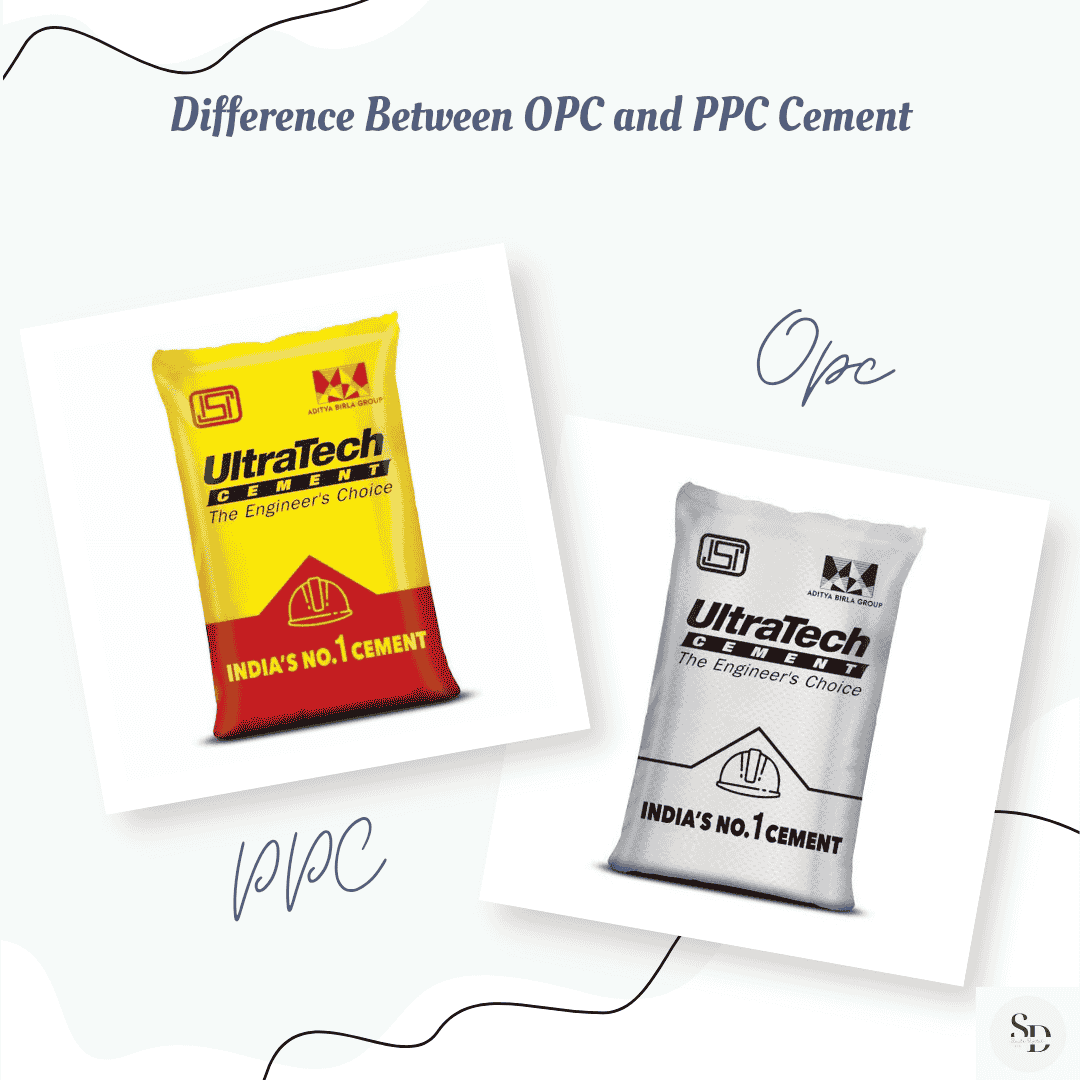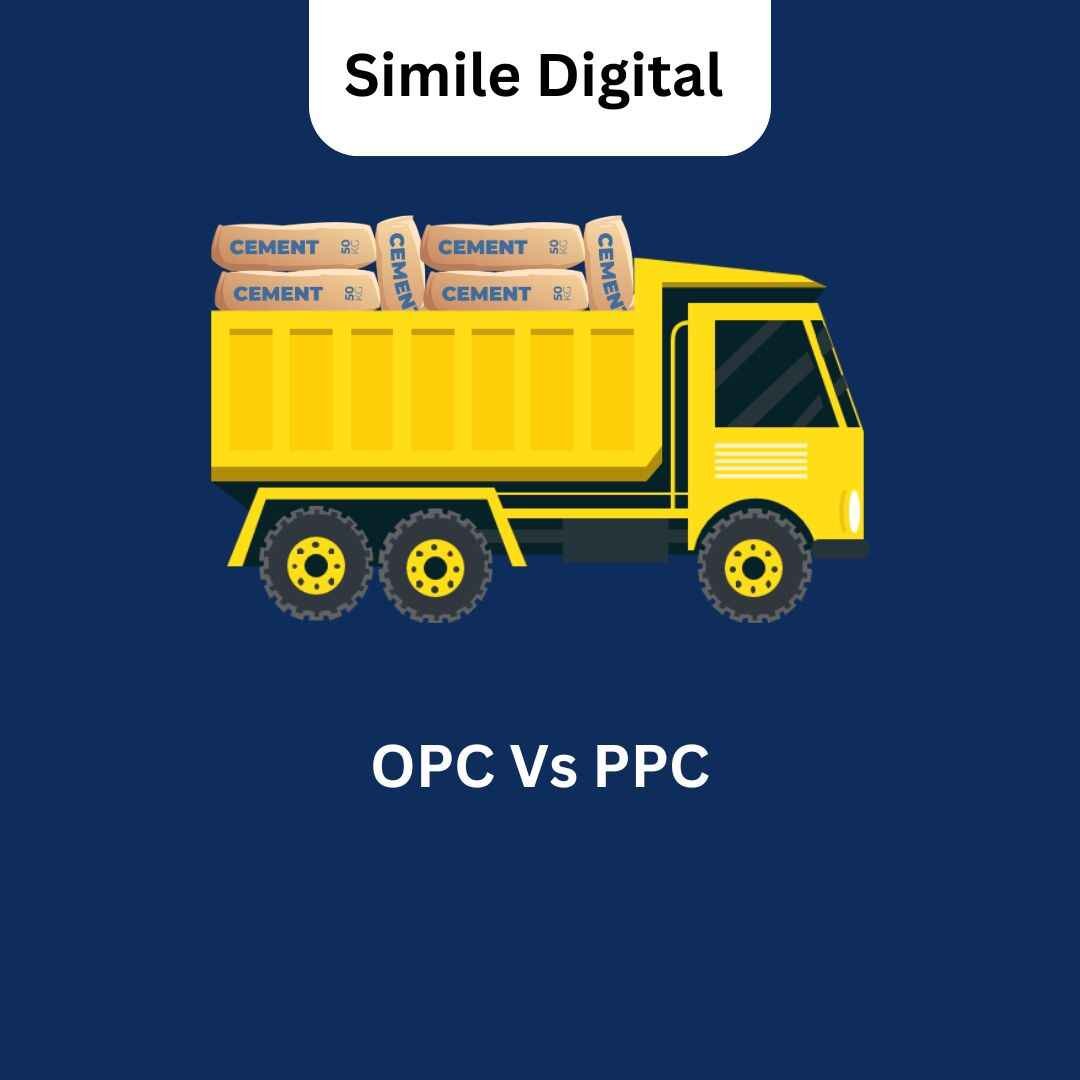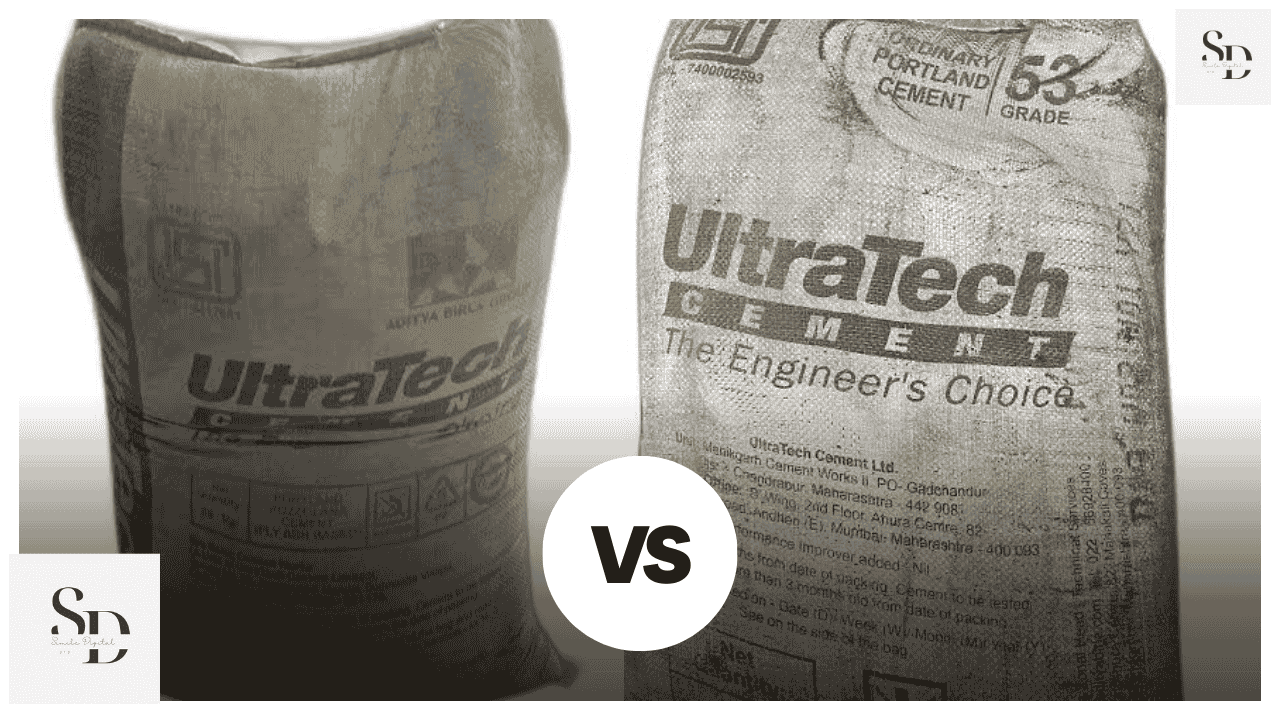Difference Between OPC and PPC Cement – Let’s Understand the difference between OPC (Ordinary Portland Cement) and PPC (Portland Pozzolana Cement), their classifications, applications, and which one is more suitable for construction.

Table of Contents
Introduction
Cement is an essential component in building, crucial for creating robust and long-lasting structures. In India, two of the most prevalent types of cement are Ordinary Portland Cement (OPC) and Portland Pozzolana Cement (PPC). Although both are utilized in concrete production, they possess distinct characteristics, strengths, and uses.
OPC is celebrated for its rapid strength gain, which makes it ideal for projects that need swift completion. Conversely, PPC is appreciated for its longevity and resistance to moisture and chemicals, making it well-suited for long-term endeavors.
In this article, we will cover:
- What is OPC cement?
- What is PPC cement?
- Their classifications and applications
- Main differences between OPC and PPC cement
Types of Cement
Various types of cement are utilized in construction, each with distinct characteristics. According to Indian Standards, the primary types of cement include:
- Ordinary Portland Cement (OPC): The most widely adopted cement for general construction activities.
- Portland Pozzolana Cement (PPC): Enhanced with pozzolanic materials for improved durability and moisture resistance.
- Rapid Hardening Cement: Quickly achieves strength, suitable for fast-paced projects.
- Sulphate Resisting Cement: Specifically crafted for environments rich in sulphates, like sewage treatment facilities.
- Low Heat Cement: Generates less heat during hydration, optimal for extensive concrete pours.
- High Alumina Cement: Known for early strength and chemical resistance.
- White Cement: Employed in decorative applications, tiles, and architectural features.
- Blast Furnace Slag Cement: Incorporates slag for greater resilience against harsh weather.
- Expansive Cement: Ideal for scenarios requiring controlled expansion, such as grouting.
- Hydrophobic Cement: Designed for humid storage conditions, preventing water absorption.

What is OPC Cement?
Ordinary Portland Cement (OPC) is the most popular cement option in construction. Composed of grinding clinker (a mix of limestone and clay) with gypsum, OPC is noted for its swift strength gain, which is advantageous for projects requiring quick completion.
Grades of OPC Cement:
OPC is available in three grades, categorized by strength after 28 days:
- OPC 33 Grade: Suitable for low-strength applications like plastering and flooring.
- OPC 43 Grade: Commonly used for residential buildings, bridges, and general construction.
- OPC 53 Grade: High-strength cement employed for significant structures and high-rise buildings.
Uses of OPC Cement:
- Ideal for roads, bridges, and flyovers due to rapid setting characteristics.
- Utilized in precast concrete constructions and heavy foundations.
- Preferred where a quick initial strength is essential.

What is PPC Cement?
Portland Pozzolana Cement (PPC) is a variant of OPC that incorporates pozzolanic materials like fly ash or volcanic ash. These additions enhance the durability of the cement, increasing its resistance to chemicals, moisture, and environmental damage. While PPC strengthens gradually, it typically outperforms OPC in the long term.
Grades of PPC Cement:
In contrast to OPC, PPC does not have defined grades; its strength is contingent on the quality of pozzolanic materials used in its manufacturing.
Uses of PPC Cement:
- Applied in dam construction, bridges, and hydraulic structures.
- Excellent for plastering and masonry tasks due to its smooth finish.
- Recommended for mass concrete projects like foundations and marine structures.
OPC vs. PPC : The Comparison
Now that we have an understanding of OPC and PPC cement, let’s examine how they compare across various factors, including composition, strength, durability, setting time, and application.
- Composition and Manufacturing Process
The primary difference between OPC and PPC lies in their composition. OPC is created by grinding clinker (limestone and clay mixture) with gypsum, without any extra materials. Conversely, PPC is produced by adding pozzolanic materials to OPC, which not only bolsters durability but also makes PPC an eco-friendlier choice by utilizing industrial by-products like fly ash.
- Strength Development and Final Strength
OPC strengthens significantly quicker than PPC, making it preferable for projects needing immediate strength, such as roads, bridges, and precast structures. However, PPC takes longer to solidify but can ultimately reach greater or equivalent strength to OPC, making it suitable for largescale constructions like dams where durability is crucial.
- Durability and Chemical Resistance
In terms of durability, PPC outperforms OPC. The pozzolanic materials react with calcium hydroxide in PPC, forming additional cementitious compounds that increase density and reduce porosity. This results in superior resistance to harsh environments, including exposure to sulphates, chlorides, and acids. In contrast, OPC has a higher lime content, which makes it more vulnerable to chemical damage and often necessitates protective treatments.
- Heat of Hydration and Risk of Cracking
The heat of hydration is the warmth produced during cement’s reaction with water. OPC generates more heat, potentially leading to cracks in mass concrete projects like dams. PPC, with a lower heat of hydration, significantly reduces thermal cracking risks, making it more suitable for substantial construction works where temperature control is vital.
- Setting Time and Workability
OPC sets more quickly than PPC, which is beneficial for urgent projects like road repairs. However, this quick setting requires careful management to avoid premature hardening. PPC has a slower setting time, promoting improved workability and ease of application, which is ideal for tasks like plastering where a smooth finish is desired.
- Environmental Impact and Sustainability
PPC is generally regarded as the more eco-friendly choice compared to OPC. Producing OPC is energy-intensive, resulting in higher CO₂ emissions due to the heating needed for clinker production. In contrast, PPC employs industrial waste like fly ash, minimizing the carbon footprint, which makes it suitable for sustainable construction initiatives.
- Cost and Affordability
PPC is often more economical than OPC because it incorporates less expensive pozzolanic materials, reducing reliance on costly clinker. This cost-effectiveness makes PPC an attractive option for large projects where budget is a significant consideration. On the other hand, OPC commands a higher price due to its rapid setting characteristics and high strength, being favored in urgent construction scenarios.
- Water Absorption and Moisture Resistance
PPC exhibits lower permeability than OPC, absorbing less water and offering superior resistance to moisture. This quality makes PPC especially favorable for water-exposed structures like basements, bridges, and sewage systems. In contrast, the greater porosity of OPC can lead to increased water absorption, which may weaken the concrete over time.
- Shrinkage and Cracking Issues
OPC’s quicker setting and higher heat generation contribute to a greater likelihood of shrinkage cracks if not properly cured. On the flip side, PPC’s slower hydration reduces shrinkage concerns, making it a dependable option for long-lasting structural integrity while minimizing surface cracks.
- Application Areas and Suitability
OPC is favored in projects requiring fast construction and high early strength, like high-rise buildings and highways. Conversely, PPC’s enduring durability and chemical resistance make it suitable for mass pouring, marine projects, and residential builds. The choice between OPC and PPC hinges on project specifics, environmental conditions, and the desired lifespan of the structure.

One-Line Comparison Between OPC and PPC Cement
- Composition: OPC comprises clinker and gypsum; PPC includes pozzolanic materials plus clinker and gypsum.
- Strength Development: OPC strengthens quickly initially; PPC takes longer but can equal or surpass OPC’s strength over time.
- Durability: PPC is more durable with lower permeability and higher chemical resistance than OPC.
- Setting Time: OPC sets quickly, suitable for urgent construction; PPC has a slower setting time, reducing shrinkage issues.
- Heat of Hydration: OPC generates more heat, raising crack risks; PPC’s lower heat makes it appropriate for large pours.
- Chemical Resistance: PPC provides superior protection against sulphates, chlorides, and acids than OPC.
- Water Absorption: PPC has less permeability, making it advantageous for waterproofing; OPC absorbs more moisture.
- Workability: PPC allows for easier handling and provides a smoother finish than OPC.
- Environmental Impact: PPC is more sustainable by using waste materials, whereas OPC is less environmentally friendly.
- Cost: PPC is typically more affordable due to its pozzolanic content; OPC is pricier but needed for rapid projects.
- Shrinkage and Cracking: OPC is more prone to cracks; PPC mitigates this with its gradual hydration.
- Cold Weather Usage: OPC is better suited for cold conditions due to its quick setting, while PPC may struggle in freezing temperatures.
- Best for Plastering: PPC excels in plastering applications due to its smooth consistency and strong adhesion.
- Load-Bearing Capacity: OPC is ideal for heavy-duty structures, while PPC is preferred for lighter, general builds.
- Marine Structure Suitability: PPC is the go-to for marine and underwater applications because of its moisture resistance.
- Curing Requirement: OPC needs less curing time; PPC requires extended curing for optimal strength.
- Sustainability: PPC is a more sustainable option given its lower carbon output; OPC is less so due to its high clinker content.
- Construction Flexibility: PPC allows for more extensive working time due to its slower setting; OPC requires prompt application to avoid hardening too soon.
- Availability: OPC is readily available for fast-paced construction, while PPC is gaining traction due to its cost-effectiveness and durability.
- Long-Term Performance: PPC generally offers better long-term durability, while OPC is suited for short-term strength needs.
Advantages and Disadvantages of OPC and PPC Cement
Advantages of OPC Cement
1. High Early Strength: OPC gains strength quickly, making it ideal for projects requiring early formwork removal.
2. Faster Setting Time: Suitable for rapid construction projects like roads and bridges.
3. Better in Cold Weather: Sets faster in low temperatures, reducing delays.
4. Widely Available: Easily available in different grades (33, 43, 53) for varied construction needs.
5. Preferred for Load-Bearing Structures: Provides high compressive strength, making it ideal for high-rise buildings and heavy structures.
Disadvantages of OPC Cement
1. Higher Heat of Hydration: Increases the risk of cracks in mass concreting applications.
2. Less Durability: More prone to chemical attacks and water damage over time.
3. Environmental Impact: High CO₂ emissions due to clinker production.
4. More Shrinkage and Cracking: Higher risk of shrinkage cracks if not properly cured.
5. Higher Cost: More expensive compared to PPC due to higher clinker content.
Advantages of PPC Cement
1. Better Durability: More resistant to chemicals, moisture, and sulphates, making it ideal for marine structures.
2. Low Heat of Hydration: Reduces cracking in mass concreting applications.
3. Eco-Friendly: Utilizes fly ash, reducing carbon emissions and promoting sustainability.
4. Improved Workability: Provides a smoother finish and better bonding with concrete.
5. More Affordable: Generally cheaper than OPC, making it cost-effective for residential projects.
Disadvantages of PPC Cement
1. Slower Strength Gain: Takes longer to gain strength compared to OPC.
2. Longer Curing Time: Requires prolonged curing to achieve optimal strength.
3. Not Ideal for Cold Weather: Slower setting in low temperatures can delay construction.
4. Limited Availability in Some Areas: Not as widely available as OPC in certain regions.
5. Not Suitable for Quick Repairs: Due to its slower setting time, PPC is not ideal for urgent repair works.
Conclusion
Selecting between OPC and PPC cement relies on the nature of the construction project, budget considerations, and longevity requirements. OPC (Ordinary Portland Cement) is ideal for instances where rapid strength and quick setting times are essential, as in roads, bridges, and tall buildings. Meanwhile, PPC (Portland Pozzolana Cement) excels in providing durability, moisture resistance, and environmental sustainability, making it well-suited for homes, marine projects, and expansive concrete works.
From an ecological standpoint, PPC is a more sustainable choice due to its incorporation of industrial by-products, which reduces CO₂ emissions. It also features lower permeability, enhancing its resistance to water and chemical factors. While OPC may provide greater strength initially, it is more vulnerable to shrinkage cracks if not adequately cured.
In terms of cost, PPC is typically the more budget-friendly option, appealing for residential and commercial construction. Nevertheless, OPC remains the preferred choice for projects demanding quick turnaround times. Engineers and builders ought to carefully evaluate their project needs when selecting the right cement type.
In summary, both OPC and PPC cement possess their distinct advantages, and the appropriate selection depends on aspects such as structural demands, setting times, durability requirements, and environmental conditions.

Thank You Note
Thank you for taking the time to read this detailed guide on the difference between OPC and PPC cement. I hope this information has helped you understand their unique properties, advantages, and applications. Whether you are a civil engineer, a builder, or a homeowner planning construction, making the right cement choice is crucial for a strong and durable structure. Stay informed and choose wisely for the best construction results!
For more comparisons and insights, visit our blog regularly. If you have any questions or suggestions, feel free to leave a comment or contact us directly.
Some of the best books on cement and concrete technology
1. Properties of Concrete – A.M. Neville
One of the most comprehensive books on concrete, covering cement composition, hydration, strength development, and durability.
2. Concrete Technology – M.S. Shetty
A widely used book in civil engineering that explains cement types, properties, and its role in concrete with practical applications.
3. Cement Chemistry – H.F.W. Taylor
A detailed book on the chemical composition and reactions of cement, ideal for those interested in cement science.
4. Concrete: Microstructure, Properties, and Materials – P. Kumar Mehta & Paulo J.M. Monteiro
Covers cementitious materials, hydration process, durability, and sustainability aspects of cement and concrete.
5. Lea’s Chemistry of Cement and Concrete – Peter Hewlett
A classic reference book for understanding the chemistry, properties, and applications of cement and concrete.
Frequently Asked Questions (FAQs)
Can OPC and PPC be mixed together?
Which cement is better for plastering and finishing work?
Is PPC cement cheaper than OPC?
Which cement is more environmentally friendly?
Does PPC cement take longer to set?
Which cement is better for house construction?
Which cement is stronger, OPC or PPC?
Note for Readers
If you’d like to read this blog in your regional language or any other international language, simply click on the Google Translator option located in the bar at the top of the page. This feature allows you to select your preferred language and enjoy the content in a way that’s comfortable for you. We hope this makes your reading experience more enjoyable and accessible!
Disclaimer
The information provided in this article is for general knowledge and educational purposes only. While every effort has been made to ensure accuracy, cement properties and construction techniques may vary based on environmental conditions, project requirements, and brand specifications. It is always recommended to consult a qualified civil engineer or construction professional before making any final decisions regarding cement selection.
For more exciting topics, explore our other articles here
ChatGPT vs DeepSeek: Which AI Chatbot Reigns Supreme in 2025?
6 Comments